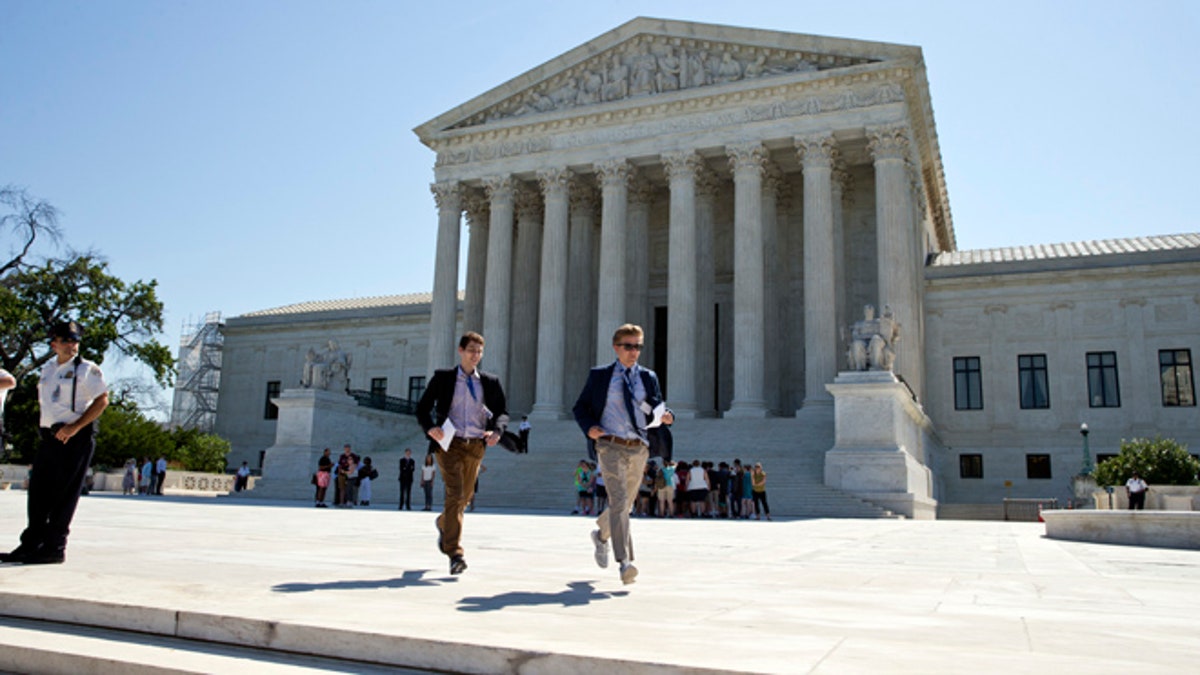
Gregory Briker, left, and John Bat, both with CBS News, run from the Supreme Court in Washington, Monday, June 20, 2016, with papers announcing court decisions. (AP Photo/Alex Brandon) (Copyright 2016 The Associated Press. All rights reserved. This material may not be published, broadcast, rewritten or redistribu)
Preserving the use of affirmative action at universities and colleges around the country, the U.S. Supreme Court upheld an admissions program at the University of Texas that helps Hispanic and black prospective students.
By a 4-3 vote, the court rejected Abigail Fisher’s claim that she was denied admission to the university’s flagship campus in Austin in 2008 over African-American students with lower grades and test scores. Fisher is white.
University officials argued that Fisher, who did not graduate in the top 10 percent of her high school class, would not have been admitted with or without race playing a role. But they did offer to allow her to transfer in as a sophomore if she maintained a 3.2 grade point average at another public college in Texas.
Texas is unique in marrying the top 10 plan to a separate admissions review in which race is one of many factors considered. The university's current freshman class is 22 percent Hispanic and 4.5 percent African-American. White students make up less than half of the school's freshmen.
According to the New York Times, the program has produced significant racial and ethnic diversity. In 2011, 26 percent of the freshmen who were enrolled under the program were Hispanic and 6 percent were black.
Justice Anthony Kennedy said in his majority opinion that the Texas plan complied with earlier court rulings allowing colleges to take account of race in pursuit of diversity on campus. "The university has thus met its burden of showing that the admissions policy it used ... was narrowly tailored," Kennedy wrote.
The court's three more conservative justices dissented, and Justice Samuel Alito read portions of his dissent from the bench.
In a separate dissent, Justice Clarence Thomas repeated his view that the Constitution outlaws any use of race in higher education admissions.
Just seven justices participated in the decision since Scalia's death in February. Justice Elena Kagan sat out the case because she worked on it while serving in the Justice Department.
Fisher rejected the university’s offer and went to Louisiana State University, from which she graduated in 2012, and pursued her lawsuit.
Fisher was recruited for the suit by Edward Blum, an opponent of racial preferences who has been remarkably successful in persuading the Supreme Court to hear cases challenging the use of race in education and politics. Blum was behind a major challenge to the landmark Voting Rights Act that resulted in the court eviscerating a key provision of the law and he also led an unsuccessful challenge to states' widespread practice of counting all their residents, not just those eligible to vote, in drawing legislative districts.
Justices heard Fisher's case once before, and issued an inconclusive ruling in 2013 that sent her case back to a lower court and set the stage for Monday's decision.
In 2003, the justices reaffirmed the consideration of race in the quest for diversity on campus. Their decision then set a goal of doing away with such programs in 25 years.
Eight states prohibit the use of race in public college admissions: Arizona, California, Florida, Michigan, Nebraska, New Hampshire, Oklahoma and Washington.
Based on reporting by the Associated Press.




